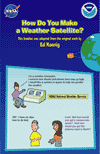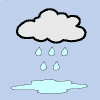
How do you make a weather satellite?
Booklet in .pdf or Flash format that explains in very basic terms how orbits work and all the components needed to build a satellite that senses temperature, takes images, and finds out other information about the weather from space. Written by a weather satellite engineer, also includes his notes and background material for presenting the topic using the booklet in the classroom. Spanish and Italian translations are also available in .pdf form.
Disciplines:
Earth science, physics, engineering design
Activity:
Group Activity

Write the Book on Weather Metrics
Introduces weather terminology. Invites students to investigate how we measure the weather and other characteristics of the atmosphere and create their own "Book of Weather Metrics."
Disciplines:
Math, science, technology, art
Activity:
Individual creative classroom and homework assignment.

The teacher sets up three simulated "clouds" representing three different cloud types. Students use different methods to estimate "precipitation" contents of each cloud type. Each method is roughly analogous to methods actually used in weather forecasting. Finally, the "precipitation" from each cloud will be released, and the students will compare their estimates to what is actually experienced on the "ground."
Disciplines:
Earth science (weather) and technology, math (estimating, percentages, ratios, and averages)
Activity:
Classroom demo, observation and recording, discussion.

Learn about Earth's water cycle and water budget. Do a poster or mural that shows some of the ways water is transported from place to place on Earth.
Disciplines:
Earth science, visual arts
Activity:
Reading, discussion, and group (small or whole class) visual art project.




